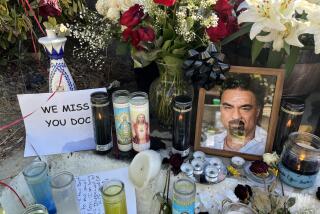Lap-Band death blamed on anesthesiologist
- Share via
An anesthesiologist’s “suboptimal” care caused a woman to die after recent weight-loss surgery at a Beverly Hills clinic connected to the 1-800-GET-THIN advertising campaign, according to an autopsy report by the Los Angeles County coroner.
The report does not identify the anesthesiologist, but lawyers for the clinic and the dead woman’s family said it was Dr. Daniel Shin, a Marina del Rey physician. Shin was on probation with the state medical board at the time of the surgery because of his conviction for assaulting a process server with a meat cleaver, according to medical board records.
Tamara Walter died Dec. 26, three days after she had a Lap-Band device implanted at the Beverly Hills Surgery Center, a lawyer for her family said. She is one of four Southern California patients to die after Lap-Band surgeries in the last two years at clinics that received referrals from the 1-800-GET-THIN advertisements, according to interviews with relatives of the deceased patients, lawsuits and autopsy reports.
Shin did not respond to interview requests. Robert Silverman, an attorney who represents the surgery centers and the 1-800-GET-THIN marketing company, said in an email that Shin was unfairly blamed in the autopsy report. Silverman has previously said the other deaths were not the fault of the surgery centers, the doctors who performed the surgeries or the marketing firm.
Shin “has voluntarily taken a leave of absence,” Silverman wrote in the email, and the surgery center “does not expect Dr. Shin to seek reinstatement of his privileges” to treat its patients.
Walter’s sister Betty Brown said Walter would not have elected to have the surgery if she had known that her anesthesiologist was on probation from the medical board because of a conviction for a violent assault.
“I’m frustrated. I’m angry. It’s unbelievable. Every time we turn around we find something else,” Brown said. “What kind of operation are they? This just tells me they don’t care about the people they hire; they just care about the money. They just roll people out like an assembly line.”
Silverman sent The Times an email defending the center’s decision to allow Shin to treat its patients. The email said Shin’s arrest and conviction were “an isolated instance of character deviation not related to the care and treatment of patients.” He said Shin was a skilled anesthesiologist with 20 years of experience.
Silverman added that the 1-800-GET-THIN marketing company “does not have any record indicating” Walter called that number to schedule her appointment.
Torrance police officers arrested Shin on Nov. 18, 2006, after he allegedly swung a meat cleaver at a process server who went to his house to serve him legal documents, said Torrance Police Sgt. Jeremiah Hart. The arrest report did not identify the documents that process server Adam Black was trying to serve.
Black told police that Shin came to his front door and screamed, “Get the hell out of here! Get out of here now!” and then swung the cleaver at him “in a downward slashing motion,” but the nearly 6-inch blade did not strike Black, Hart said.
Black fled and told one of the anesthesiologist’s neighbors to call police, Hart said. Police officers arrested Shin without incident, Hart said.
Prosecutors charged Shin with felony assault with a deadly weapon. As part of a plea bargain, Shin pleaded no contest Jan. 25, 2007, to misdemeanor assault with a deadly weapon, according to court records. He was placed on probation for three years, fined $120 and ordered to undergo 26 weeks of anger-management counseling. He was also ordered to perform 472 hours of community service, according to court records.
Shin submitted a letter on Oct. 16, 2008, indicating he had completed his community service. Two years later, a judge set aside the no-contest plea and dismissed the case, according to court records.
In 2009, the medical board placed Shin on two years’ probation for the meat cleaver incident and ordered him to undergo a psychiatric evaluation and ethics training. He was allowed to continue treating patients, according to the medical board’s ruling. A spokeswoman for the board declined to comment.
Kathryn Trepinski, an attorney representing Walter’s family, said the assault conviction was troubling.
“I would want an anesthesiologist who’s calm and collected and good under pressure,” she said.
Kevin Young, a Los Angeles County deputy medical examiner, concluded in the March 21 autopsy report that Walter’s death was an “accident due to suboptimal anesthesia care.” That finding was based in part on a report by consulting anesthesiologist Selma H. Calmes.
Calmes, who retired as the chief of anesthesiology at UCLA-Olive View Medical Center in 2004, made her findings after reviewing medical records about Walter’s treatment.
She faulted the anesthesiologist for leaving Walter in the care of a nurse for 80 minutes after the surgery. Shortly after the anesthesiologist returned, Walter went into cardiac arrest, Calmes’ report said. Paramedics took Walter to nearby Cedars-Sinai Medical Center, where she died three days later.
Calmes concluded that obesity and sleep apnea, a disorder that causes nighttime breathing problems, made it difficult for Walter to breathe while recovering from surgery. Walter’s sleep apnea was so severe that she used a breathing machine at home, according to Calmes’ report and to Trepinski, the family lawyer.
Calmes’ report said Walters’ respiratory problems led to the cardiac arrest and that successful treatment calls for “the big guns,” which includes prompt admission to an intensive-care unit.
“Usually, this resolves with prompt, aggressive management. Here, there were excessive delays in getting the patient to suitable treatment,” Calmes’ report said. “Especially problematic is the anesthesiologist’s absence” after the surgery.
The American Society of Anesthesiologists recommends that patients with sleep apnea who use breathing machines be placed under general anesthesia only in a hospital, not outpatient clinics such as the one where Walter was treated, Calmes wrote in her report.
Silverman, the surgery center’s attorney, said he had “numerous questions and concerns about the opinions of Dr. Calmes.”
“The guidelines stated in the autopsy report are outdated and have been specifically refuted by numerous current studies,” Silverman wrote in his email.
Shin monitored Walter “the entire time she was in the recovery room,” Silverman wrote in the email. “There is no record of any gap in supervision.”
Silverman sent the coroner’s office a letter dated March 24 demanding that Calmes’ consulting report be removed from the autopsy report. He contended that Calmes had a conflict of interest because she “either is currently employed or was employed by UCLA Medical Center, an entity that competes directly with my client.”
The county’s chief medical examiner, Lakshmanan Sathyavagiswaran, rejected Silverman’s request in an April 6 letter that described Calmes’ report as “thorough and accurate.”
Walter, 52, a grocery store assistant manager who lived in Lawndale, is one of three patients to die in the last two years after Lap-Band surgery at an outpatient center at 9001 Wilshire Blvd., Beverly Hills. The center has used several names, including Beverly Hills Surgery Center and, most recently, New Life Surgery Center.
Ana Renteria, 33, of Norwalk and Willie Brooks Jr., 35, of Perris were the other two patients who died at the Beverly Hills clinic. A fourth patient, Laura Faitro, died after surgery at an associated center in West Hills.
The three deaths have prompted legal action:
Renteria’s family filed a lawsuit in February accusing surgeon Atul Madan, the 1-800-GET-THIN marketing company and others of contributing to her death. The defendants have not yet filed a response.
Faitro’s family filed a lawsuit in February that faulted surgeons Kevork George Tashjian and Ihsan Shamaan, 1-800-GET-THIN and others for her death; those defendants have yet to file responses.
Last year, Brooks’ family sued the clinic owners and surgeon Tashjian. The Brooks lawsuit is scheduled to go to trial in June. Tashjian and other defendants have denied wrongdoing.
Relatives of Renteria and Faitro filed an additional lawsuit Feb. 4 against 1-800-GET-THIN and other defendants, alleging that their advertising was misleading. The lawsuit seeks class-action status. The families accused the defendants of false advertising, saying the ads failed to provide adequate warnings about the risks of the surgery. The lawsuit also said that while the defendants advertised that they employed “top rated surgical specialists,” the defendants’ principals included two brothers, Julian and Michael Omidi, who had been disciplined for misconduct by the state medical board.
Silverman issued a statement saying the lawsuit was “without any legal or factual merit.” The case’s first court hearing is set for May 11.
Trepinski, the Walter family’s attorney, said the history of lawsuits and disciplinary records provides insight into the surgery center’s operations.
“Tamara Walter believed she was in good hands, and she sought out this Beverly Hills clinic in particular,” Trepinski said. “As it turns out, this could have been the decision that killed her.”
More to Read
Sign up for Essential California
The most important California stories and recommendations in your inbox every morning.
You may occasionally receive promotional content from the Los Angeles Times.











